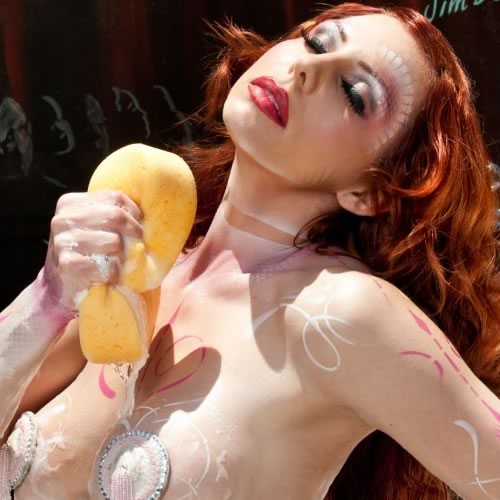If all dance performance were like an ice cream sundae, burlesque would surely be the chocolate syrup, a silky slow-pour of sinful, decadent, and naughty sweetness that playfully covers the top, revealing sections of the coveted cool cream underneath. As opposed to strippers, whose sole goal is to unload their garments and dance in the nude, the charm of the burlesque dancer lies in the striptease itself, a sensual, seductive, and slow removal of clothing piece by piece, taunting onlookers into a fervid frenzy. But believe it or not, burlesque wasn’t always this way. In fact the art of burlesque started out more as an SNL skit rather than a Las Vegas revue.
The style of burlesque was born in the European cabarets of the 19th century, specifically in France with the inception of the can-can at the Moulin Rouge, and in England with performers like Lydia Thompson and her troupe of British Blondes. However the bawdiness of burlesque was not its initial defining characteristic.
The term burlesque is thought to be of Italian origin, coming from the word burla meaning joke or mockery. That’s because originally burlesque was intended to make people laugh, as opposed to its modern purpose of turning them on. In the beginning, music halls in 19th century England began showcasing satirical theater entertainment geared towards the poor and middle classes, poking fun at the habits and lifestyle of the upper class, acting as a form of social commentary. Shows would even parody popular theatrical pieces, operas, and Shakespearean plays.
By the 1860s, burlesque acts started to include underdressed women in order to maintain audience interest, a big contrast to the strict Victorian dress of the time which involved women being very covered up in girdles, hoops, and bustles. The lengths to which these curvaceous and voluptuous women (probably considered fat by today’s standards) would go were relatively tame compared to the later place burlesque would eventually end up, revealing mainly legs in tights.
By the late 1860s, Lydia Thompson and her British Blondes had moved their show to New York City, introducing burlesque to 19th century America. Their first show Ixiom featured underdressed women playing men’s roles and was an instant success. Soon burlesque acts began popping up all across the entire nation. By the late 1800s, the American burlesque format consisted of comic sketches, acrobats, magicians, singers, a play, and a finale of an exotic dancer.
In the 1920s burlesque had evolved from a song and dance variety show into full striptease and burlesque performers started to become famous for their not-so-hidden assets. G-strings and pasties were all that was left for those burlesque performers who opted out of full nudity. The comedy aspect of burlesque was completely gone by this period, the audience now mainly constituted of men coming to watch performers like Gypsy Rose Lee take it all off.
In the 1930s and 1940s American government began cracking down on burlesque clubs, implementing stricter rules and outlawing burlesque in certain states. In New York Mayor Fiorello LaGuardia had burlesque outlawed by the 1940s, putting it virtually out of business in the Big Apple. However around this time period, the birth of the pin-up model in dirty magazines helped keep burlesque alive amid heavy censorship and government crackdown, with models featured in magazines performing special engagements at burlesque clubs to help attract audiences.
By the 1950s other forms of entertainment such as television and film had taken the nation hostage, and the steady decline of burlesque had begun. The popularity of the hourglass woman, such as Marilyn Monroe, Jayne Mansfield, and the underground Bettie Page, began capturing the attention of men. And by the 1960s full-fledged hardcore porn is easily available, virtually killing the entire art of burlesque. Although its remnants survive in the forms of go-go dancing and the Las Vegas showgirl, burlesque does not make a full return until the mid 1990s.
By that time, a new generation initiated a resurgence in burlesque art, aspiring to replicate the glamour of the old ages, and in resistance to the omnipresence of the hypersexuality of pornography. New clubs started opening in major cities featuring performers like the very popular Dita Von Teese, bringing the heyday of burlesque to a new audience, albeit in a slenderized, tattooed, and pierced version. By the late 1990s burlesque had started to poke back into the mainstream public eye with dance-ensemble-turned-pop-group The Pussycat Dolls doing shows at famed Los Angeles nightclubs The Viper Room and The Roxy. Even though today burlesque continues its journey back to the spotlight with feature films like Burlesque and performance troupes like yours truly, it will never quite return to the popularity levels of the Roaring 20s.
At its heart the objective of modern burlesque is to turn people on by slowly exposing skin or undergarments in suggestive and provocative dance moves. The allure of burlesque is in the tease and not the full strip. Burlesque performers need to be sensual, playful, and cheeky all at the same time. Expressions such as gasping, winking, smiling, and laughing all add to the appeal of the burlesque striptease, perpetuating the notion that the viewer is witnessing something that should not be seen, something taboo. Finally burlesque routines usually align with a specific type of music, the 1940s big band show music focused on a heavy and slow bass drum beat, allowing the performer to take her time in disrobing.
If there’s anyone who’s got a handle on the delicate art of burlesque, its Zen Arts. For a first-hand look at the fun of modern burlesque, call 855-ZEN-ARTS or email to [email protected] to inquire about Zen Arts burlesque dancer bookings.


